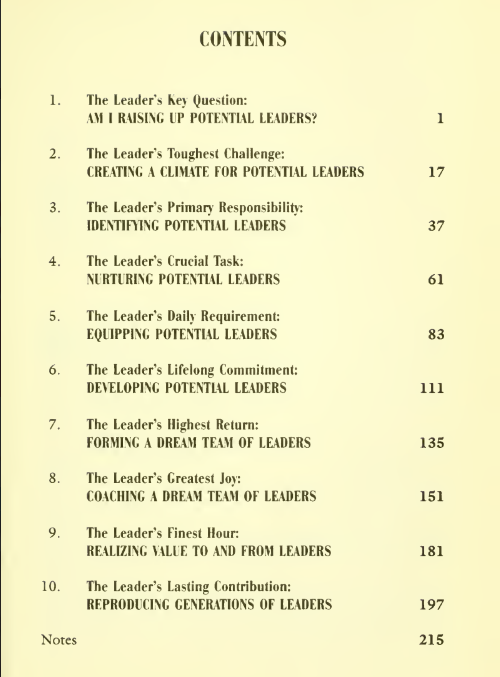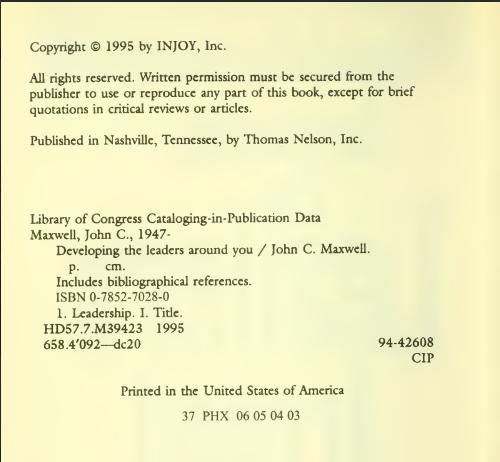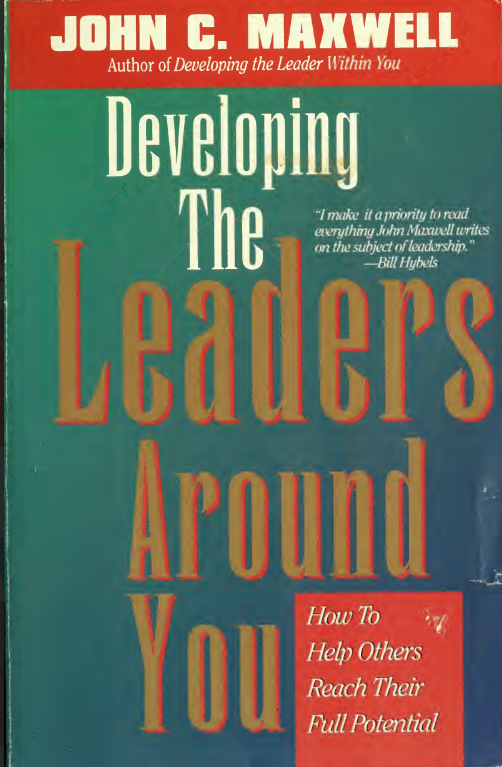


One night, after working quite late, I grabbed a copy of Sports Illustrated, hoping its pages would lull me to sleep. It had the opposite effect. On the back cover was an advertisement that caught my eye and got my emotional juices flowing. It fea- tured a picture of John Wooden, the coach who led the UCLA Bruins for many years. The caption beneath his picture read, “The guy who puts the ball through the hoop has ten hands.” John Wooden was a great basketball coach. Called the wizard of Westwood, he brought ten national basketball championships to UCLA in a span of twelve years. Two back-to-back championships are almost unheard of in the competitive sports world, but he led the Bruins to seven titles in a row. It took a consistent level of superior play; it took good coaching; and it took hard practice. But the key to the Bruins’ success was Coach Wooden’s unyielding dedication to his concept of teamwork. He knew that if you oversee people and you wish to develop leaders, you are responsible to: (1) appreciate them for who they are; (2) believe that they will do their very best; (3) praise their accomplishments; and (4) accept your personal responsibility to them as their leader.
Coach Bear Bryant expressed this same sentiment when he said: “I’m just a plowhand from Arkansas, but I have learned how to hold a team together—how to lift some men up, how to calm others down, until finally they’ve got one heartbeat together as a team. There’s always just three things I say: ‘If anything goes bad, I did it. If anything goes semi-good, then we did it. If anything goes real good, they did it.’ That’s all it takes to get people to win.” Bear Bryant won people and games. Until a few years ago, he had the greatest number of wins in the history of college foot- ball. Great leaders—the truly successful ones who are in the top 1 percent—all have one thing in common. They know that acquiring and keeping good people is a leader’s most important task. An organization cannot increase its productivity—but people can! The asset that truly appreciates within any organization is people. Sys- tems become dated. Machinery wears. But people can grow, develop, and become more effective if they have a leader who understands their potential value.
THAT LEADER
The greatest leadership principle that I have learned in over twenty-five years of leadership is that those closest to the leader will determine the success level of that leader. A negative reading of this statement is also true: Those closest to the leader will deter- mine the level of failure for that leader. In other words, the people close to me “make me or break me.” The determination of a posi- tive or negative outcome in my leadership depends upon my ability as a leader to develop those closest to me. It also depends upon my ability to recognize the value that others can give my organization and me. My goal is not to draw a following that results in a crowd.
My goal is to develop leaders who become a movement. Stop for a moment and think of the five or six people closest to you in your organization. Are you developing them? Do you have a game plan for them? Are they growing? Have they been able to lift your load? Within my organizations—the leadership development institute INJOY and Skyline Wesleyan Church—leadership development is continually emphasized. In their first training session, I give new leaders this principle: As a potential leader you are either an asset or a liability to the organization. I illustrate this truth by saying, “When there’s a problem, a ‘fire’ in the organization, you as a leader are often the first to arrive at the scene. You have in your hands two buckets. One contains water and the other contains gasoline. The ‘spark’ before you will either become a greater prob- lem because you pour the gasoline on it, or be extinguished be- cause you use the bucket of water.” Every person within your organization also carries two buckets. The question a leader needs to ask is, “Am I training them to use the gasoline or the water?” Businessman Rolland Young said, “I am a self-made man, but I think if I had it to do over again, I would call in someone else!” Usually leaders fail to develop other leaders either because they lack training or because they possess wrong attitudes about al- lowing and encouraging others to come alongside them.
Often, leaders wrongly believe that they must compete with the people close to them instead of working with them. Great leaders have a different mind-set. In Profiles in Courage, President John F. Ken- nedy wrote, “The best way to go along is to get along with oth- ers.” This kind of positive interaction can happen only if the leader has an attitude of interdependency with others and is committed to win-win relationships. As a leader, I sometimes hear counsel that I don’t want to hear but need to hear. That’s the advantage of having leaders around you—having people who know how to make decisions. Followers tell you what you want to hear. Leaders tell you what you need to hear.
I have always encouraged those closest to me to give me advice on the front end. In other words, an opinion before a decision has potential value. An opinion after the decision has been made is worthless. Alex Agase, a college football coach, once said, “If you really want to give me advice, do it on Saturday afternoon between one and four o’clock, when you’ve got twenty-five seconds to do it, between plays. Don’t give me advice on Monday. I know the right thing to do on Monday.”


